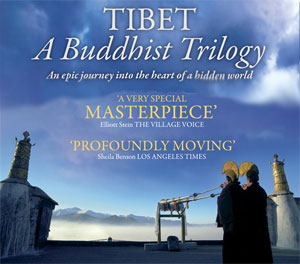Documentary immerses the viewer in Buddhism
By Robert Horton, Herald Movie Critic, April 14, 2006
Everett, WA (USA) -- In 1977 a curious Englishman named Graham Coleman shot an enormous amount of footage of Buddhist ceremonies in India, amongst exiled Tibetan Buddhists. He carved three separate documentaries out of the footage, meant to be exhibited sequentially as a long, immersive experience.
 That four-hour version was seen only sparingly. Now, Coleman has re-edited his material into a single 132-minute movie. "Tibet: A Buddhist Trilogy" is the result, a more compact film that should reach a wider audience.
That four-hour version was seen only sparingly. Now, Coleman has re-edited his material into a single 132-minute movie. "Tibet: A Buddhist Trilogy" is the result, a more compact film that should reach a wider audience.
This film is still divided into its three segments. Part One introduces us to the Dalai Lama at his home in Dharamsala in the north of India, where he and other Tibetan monks are in exile after their country was seized by China.
One might think that exile would produce bitterness. But this section climaxes with a remarkable speech in which the Dalai Lama suggests that Tibetans might learn something from the Chinese about how to deal with their displacement.
Part Two is the longest segment, and either the most taxing or the most mesmerizing, depending on your level of interest in the subject. It details a ceremony called "A Beautiful Ornament," which we witness in its entirety, or something close to it. We also see the preparation of an elaborately symbolic cosmogram - and then its destruction after the ceremony is over.
Part Three travels to a beautiful mountain valley in Ladakh, where we see farmers tilling the soil and lamas conjuring up a mandala, a sand painting (which, like the cosmogram, must be destroyed, as a representation of the impermanence of things).
There is also a stark, moving depiction of the corpse of an elderly man being prayed over and then burned. The final images recall the last shots of John Huston's film "The Man Who Would Be King," which arrives at the same place of death and impermanence, albeit through Western eyes.
As long sections of the film go by with monks chanting or music playing, subtitled Buddhist texts are provided. This is a lot to absorb, and the movie is probably better for viewers with some pre-existing interest in Buddhism (or at least spirituality), since the film aims to be an experience rather than a step-by-step introduction.
Even for non-believers, it offers stunning 35 mm photography by David Lascelles, a reminder that recent spiritual documentaries, shot on video, are missing something.
One contradiction: If these ceremonies are fleeting and impermanent, chronicling them on film locks them in place. But if this is the only way to bring the rituals out of India, so be it.
-------------
"Tibet: A Buddhist Trilogy" The rituals of Tibetan monks in exile in India, closely and beautifully filmed in 1977 and re-edited for release. Not a step-by-step intro to Buddhism, but an immersive experience, which will be mesmerizing or taxing, depending on the viewer's level of interest in the subject. (In Tibetan, with English subtitles.) Rated: Not rated; probably PG for subject matter Now showing: Varsity

 That four-hour version was seen only sparingly. Now, Coleman has re-edited his material into a single 132-minute movie. "Tibet: A Buddhist Trilogy" is the result, a more compact film that should reach a wider audience.
That four-hour version was seen only sparingly. Now, Coleman has re-edited his material into a single 132-minute movie. "Tibet: A Buddhist Trilogy" is the result, a more compact film that should reach a wider audience.